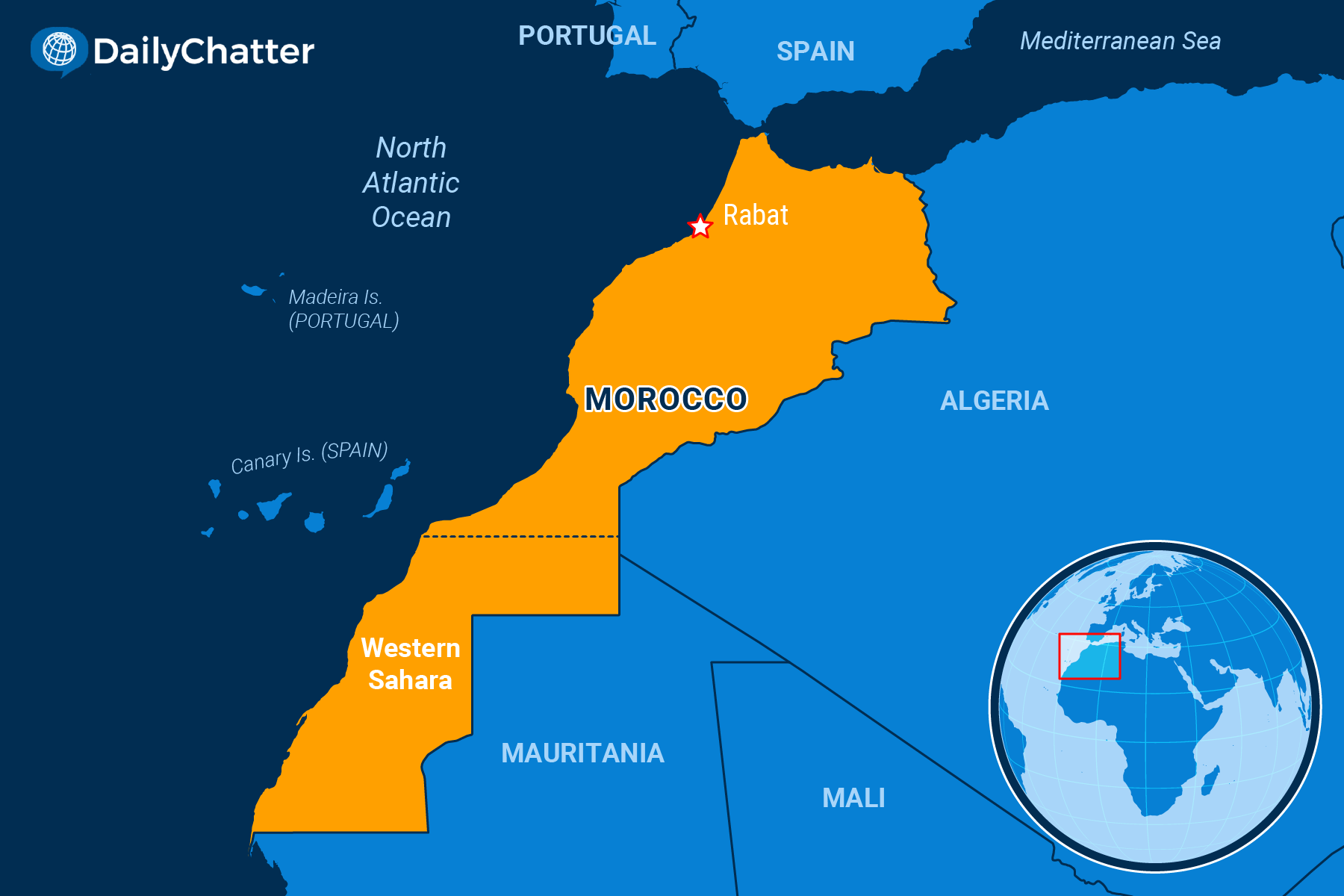
The World Today for September 26, 2023
|
Listen to Today's Edition
|
NEED TO KNOW
Bricks and Blood
MOROCCO

Mohammed Ounasser lost his wife and two daughters when a 6.8 magnitude earthquake struck Morocco on Sept. 8 and leveled their village of Tnirte in the High Atlas Mountains. “This once-idyllic hamlet, nestled in apple and apricot groves, is now just a giant pile of red clay bricks and debris,” wrote National Public Radio.
Moroccan and international responders have been picking through the rubble in Tnirte and elsewhere to find families’ loved ones, but locals said that many of them arrived late or lacked the proper equipment to help, added a France 24 video. In one presented case, the responders showed up at a village to discover demolished homes that likely buried scores of individuals. The responders had to wear surgical masks to avoid the odor of the decomposing corpses.
The International Federation of Red Cross and Red Crescent Societies noted that weather forecasts have made the responders’ job more urgent. The organizations feared that rain could trigger landslides among the rubble and unstable ground.
Almost 3,000 people have been confirmed dead due to the quake, which struck the country’s remotest and poorest areas in the High Atlas Mountains, reported Bloomberg. Another 300,000 people have lost their homes, setting the stage for a different humanitarian disaster in the near future.
Many Moroccan homes are made from traditional mud bricks and compacted earth. These structures can hold up well during earthquakes, but often poor maintenance and shoddy repairs have left them weakened over time. Moroccan officials often don’t inspect or enforce code standards, either.
Meanwhile, some locals have been complaining that the government’s response was too little, too late. At the same time, foreign leaders expressed bewilderment that their offers of help were not responded to.
Some analysts believe the disjointed emergency response is due to the constitutional monarchy that rules the country. “For a crisis that requires fast, decisive action, the government has been caught on its backfoot – a consequence of the structural features of Morocco’s political system,” wrote Intissar Fakir, director of the North Africa and the Sahel program at the Washington, DC-based Middle East Institute. “First is the extent to which the monarchy dominates decision-making, rendering action and ownership by other governmental institutions difficult. All must defer to the king and await his directives.”
Meanwhile, Morocco’s King Mohammed VI was in France, as he is a majority of the year, according to ABC.net.au, an Australian news outlet.
Instead, for example, neighbors relied on neighbors to dig survivors out of the rubble, sharing whatever food and supplies they could, the Washington Post detailed. In many places, the first outside responders to show up were private organizations or citizens who had traveled from major cities to help.
Those efforts were stymied at times. For example, in one village, Adassil, about 50 residents protested against local authorities who were stockpiling aid and had stopped outside volunteers from reaching the villagers, the Post added. After the protest, officials released the aid.
A working session chaired by the king has estimated that reconstruction will cost $11.6 billion over the next three years, wrote the Morocco World News. Those funds will help relocate displaced people and rebuild housing and infrastructure in almost 3,000 villages in which almost 2.9 million people live. A third of the nearly 60,000 damaged homes in the quake zone are completely destroyed, according to Reuters.
The king hoped that the spending would also improve the streets, roads, and Internet connectivity to promote economic development and new jobs in the now-devastated regions, areas that have long been neglected in favor of urban areas.
Moroccans will suffer mental scars due to the quake, Al Jazeera warned, relating how many people who survived can’t stop remembering how their mud brick homes crumbled around them.
Still, some locals just expressed gratitude that they survived.

THE WORLD, BRIEFLY
Boiling Point
KOSOVO

Kosovar police and ethnic Serb gunmen clashed in Kosovo’s restive northern region this week, a deadly skirmish that killed at least four people and is likely to stir up tensions between Pristina and neighboring Serbia, Reuters reported Monday.
On Sunday, gunmen attacked the village of Banjska, fighting police and barricading themselves in a Serbian Orthodox monastery. Three attackers and one police officer were killed before police retook control of the monastery.
Authorities sealed off the village Monday and began searching for the attackers.
The incident intensified long-standing ethnic disputes in Kosovo, a former Serbian province with a 90 percent ethnic Albanian majority. Around 50,000 ethnic Serbs live in the country’s north, but they have rejected Kosovo’s government following its declaration of independence from Serbia in 2008. These Serbs consider Belgrade as their capital and resist integration into Kosovo’s structures of governance.
Following the weekend clashes, Kosovo Prime Minister Albin Kurti blamed Serbia for orchestrating and financing the attack. Serbian President Aleksandar Vučić rejected the allegations and accused Kurti of stoking violence, by opposing the creation of an association of Serb municipalities and launching police operations in the north.
The United States condemned the attacks and urged both Balkan neighbors to defuse the tense situation. Russia – a traditional ally of Serbia that does not recognize Kosovo’s statehood – said it was monitoring the “tense and potentially dangerous” situation in Kosovo.
Tensions have been simmering in Kosovo following violent clashes in May that left more than 90 NATO peacekeeping soldiers and about 50 Serb protesters injured.
Observers said the recent dispute is related to the implementation of a European Union-brokered agreement from a decade ago – approved by a previous Kosovar government – which aimed to create an association of autonomous municipalities, Reuters wrote separately.
However, Kurti fears that such a move would lead to the de facto partitioning of the region along ethnic lines.

School-house Rock
NEPAL

Tens of thousands of schoolteachers marched in Nepal’s capital of Kathmandu this week to protest an education reform law, leading to the closure of around 29,000 schools attended by millions of students across the country, the Associated Press reported.
The protests, which began last week, are centered on the School Education Bill, which opponents say would shift government-run schools to local control. They maintain that such a change would lower their status and scrap many temporary teacher positions.
One of the central issues is the role of politics in education.
Nepali teachers have historically been involved in the country’s political movements, particularly in the fight for democracy, according to the BBC. However, analysts and supporters of the bill said that teachers’ political affiliations can undermine the quality of education.
They added that banning political activities in educational institutions would help keep the focus on education.
The teachers are also protesting the shift of governance in public institutions, such as schools and hospitals, to local authorities following a constitutional change in 2015. While this move aimed to address concerns about the centralization of power and resources in Kathmandu, some teachers lamented that local officials were ill-equipped to manage schools effectively, resulting in a decline in the quality of education.
Teachers’ groups and government officials are negotiating over changes to the proposed legislation.
Even so, many educators threatened that they would hold more demonstrations in the capital if their demands were not addressed.

Deadly Anniversary
IRAN

Iran thwarted 30 planned explosions in Tehran earlier this month, according to authorities, attacks aimed at creating chaos in crowded areas of the capital, Al Jazeera reported this week.
On Sunday, security forces arrested 28 individuals in connection with the planned attacks during raids in a number of provinces, including Tehran and West Azerbaijan provinces.
The Ministry of Intelligence said the goal of these planned explosions was to undermine the country’s security, and create instability and protests.
Officials added that the attacks were set to take place “exactly during the anniversary of last year’s riots,” referring to the protests that swept Iran following the death of 22-year-old Mahsa Amini.
Amini was arrested by the country’s morality police over allegations that she had violated Iran’s strict Islamic dress code.
Her death in police custody sparked mass demonstrations against the country’s ruling clerics that went on for months.
Iranian authorities said the detained individuals were members of Islamic State (IS), while adding that the technical aspects of their operations resembled the methods typically associated with Israel – Iran’s arch-rival.
IS has claimed responsibility for an attack on the Shah Cheragh shrine in Shiraz last year, which killed 13 people and injured dozens. Another attack on the same shrine in August that killed two people was also attributed to the terror group. Iran accused a number of foreign nationals of involvement in the second attack.
The Iranian judiciary recently sentenced the shooter in the second attack to death, while two other suspects received five-year prison terms and expulsion from Iran.

DISCOVERIES
Reasonably Precious
Pink diamonds are renowned for their rarity and unique color, which is caused by their bent crystalline structure.
Around 90 percent of all these precious rocks are found in Australia’s Argyle Mine. Still, their origin has puzzled scientists for years, according to Live Science.
The mine and the diamonds are located at the edge of the continent and in a type of rock that is slightly different from the ones that usually bear diamonds.
Recently, new research showed that the formation of the rock and gemstones dates back to Earth’s ancient history – more than a billion years ago.
Previous studies in the 1980s estimated the age of the rocks in Argyle at about 1.2 billion years old, but there were doubts due to limitations in the technology used.
For this new study, researchers used a series of modern techniques, including laser ablation technology, to determine the diamonds’ age.
Their findings showed that the precious stones were formed around 1.3 billion years ago. This revised age coincides with the breakup of the supercontinent Nuna.
Some 1.8 billion years ago, two pieces of continental crust collided to create Nuna, and the area in which the Argyle mine now sits formed right at this collision point. It was also during this continental smash that the diamonds eventually got their appealing hue.
Nuna eventually broke up 500 million years later which brought these pink diamonds closer to the Earth’s surface.
While the Argyle mine was shut down in 2020, there’s a chance that similar pink diamond deposits exist elsewhere on Earth.
Even so, getting to them will be a challenge because they may be buried beneath layers of eroded rock and sediment.

Thank you for reading or listening to DailyChatter. If you’re not already a subscriber, you can become one by going to dailychatter.com/subscribe.
Not already a subscriber?
If you would like to receive DailyChatter directly to your inbox each morning, subscribe below with a free two-week trial.
Support journalism that’s independent, non-partisan, and fair.
If you are a student or faculty with a valid school email, you can sign up for a FREE student subscription or faculty subscription.
Questions? Write to us at hello@dailychatter.com.


 Thank you for visiting, DailyChatter, the only daily newsletter focused exclusively on world events. We hope you enjoy reading (or listening to) this edition.
Thank you for visiting, DailyChatter, the only daily newsletter focused exclusively on world events. We hope you enjoy reading (or listening to) this edition.